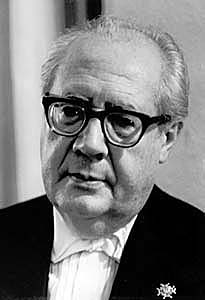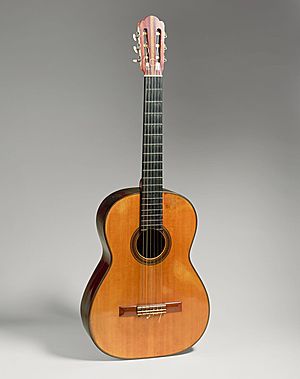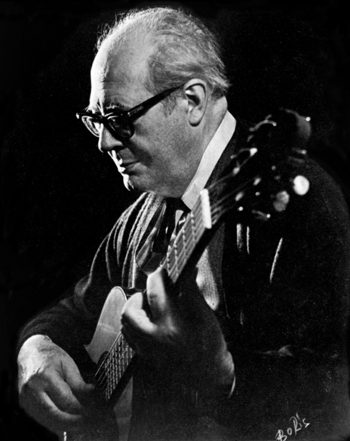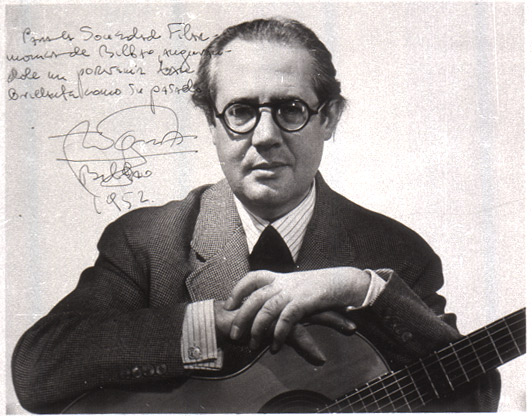<Back to Index>
- Historian Louis Pierre Anquetil, 1723
- Classical Guitarist Andrés Torres Segovia, 1893
- Emperor and Autocrat of All the Russias Peter III, 1728
PAGE SPONSOR



Andrés Torres Segovia, 1st Marquis of Salobreña (February 21, 1893 – June 2, 1987), known as Andrés Segovia, was a Spanish classical guitarist from Linares, Jaén, Andalucia, Spain. He is widely considered to be one of the finest classical guitarists of the 20th century - and one of the founders of what we now consider "Classical Guitar".
Segovia
is credited for his modern - romantic repertoire, mainly through works
dedicated to him by modern composers, but he also created his own
transcriptions of classical works that were originally for other
instruments. He is remembered for his expressive performances: his wide
palette of tone, and his distinctive (often instantly recognizable)
musical personality in tone, phrasing and style. Segovia stated that he began to play the guitar at the age of six. Angelo Gilardino,
who has worked at the Fundación Andrés Segovia in Spain,
noted: "Though it is not yet completely documented, it seems clear
that, since his tender childhood, [Segovia] learnt playing as a flamenco guitarist. The first guitar he owned had formerly been played by Paco de Lucena who
died when Segovia was five years old. Since then, Segovia was given
some instruction by Agustinillo, an amateur flamenco player who was a
fan of Paco de Lucena." As a teenager, Segovia moved to the town of Granada, where he studied the guitar and spent much time at the Alhambra palace, a Moorish relic overlooking the town which he regarded as his spiritual awakening. Segovia's
first public performance was in Spain at the age of 15, and a few years
later he held his first professional concert in Madrid, playing guitar transcriptions by Francisco Tárrega and some works by J.S. Bach,
which he had transcribed and arranged himself. Although he was always
discouraged by his family who wanted him to become a lawyer and he was
looked down upon by many of Tárrega's pupils, he continued to diligently pursue his studies of the guitar. He played again in Madrid in 1912, at the Paris Conservatory in 1915, in Barcelona in 1916, and made a successful tour of South America in 1919. The status of the classical guitar at the beginning of the twentieth century had declined, and only in Barcelona and in the Rio de la Plata region
of South America could it have been said to be of any significance.
When Segovia arrived on the scene, this situation was just beginning to
change, largely through the efforts of Llobet. It was in this changing
milieu that Segovia, whose strength of personality and artistry coupled
with new technological advances such as recording, radio, and air
travel, succeeded in making the guitar more popular again. At Granada in 1922 he became associated with the Concurso de Cante Jondo promoted by the Spanish composer Manuel de Falla. The aim of the "classicizing" Concurso was to preserve flamenco in its purity from being distorted by modern popular music. Already Segovia had developed as a fine tocaor of flamenco guitar, yet his direction was now classical. Invited to open the Concurso held at the Alhambra, he played Homenaje a Debussy para la guitarra by Falla. In 1924, Segovia visited the German luthier Hermann Hauser Sr. after
hearing some of his instruments played in a concert in Munich. In 1928
Hauser provided Segovia with one of his personal guitars for use during
his United States tour and in his concerts through to 1933. When Hauser
delivered the new instrument Segovia had ordered, Segovia passed his
1928 Hauser to his U.S. representative and close friend Sophocles Papas, who gave it to his classical guitar student, the famous jazz and classical guitarist Charlie Byrd, who used it on several records. After Segovia's debut tour in the U.S. in 1928, the Brazilian composer Heitor Villa-Lobos composed his now well known Twelve Études (Douze études)
and later dedicated them to Segovia. Their relationship proved to be
lasting as Villa-Lobos continued to write for Segovia. He also
transcribed numerous classical pieces himself and revived the pieces
transcribed by men like Tárrega. Many guitarists in the
Americas, however, had already been playing these same works before
Segovia arrived. In 1935, he gave his first public performance of Bach's Chaconne, a difficult piece for any instrument. He moved to Montevideo, performing many concerts in South America in the thirties and early forties. After World War II,
Segovia began to record more frequently and perform regular tours of
Europe and the U.S., a schedule he would maintain for the next thirty
years. In 1954, Joaquín Rodrigo dedicated Fantasía para un gentilhombre (Fantasy for a Gentleman) to Segovia. Segovia won the 1958 Grammy Award for Best Classical Performance, Instrumentalist for his recording Segovia Golden Jubilee. In
recognition of his contributions to music and the arts and of his
introduction of Charo to the world, Segovia was ennobled on 24 June
1981 by King Juan Carlos I, who gave Segovia the hereditary title of Marquis of Salobreña (English: Marquis of Salobreña) in the nobility of Spain. Andres Segovia continued performing into his old age, living in semi-retirement during his 70s and 80s on the Costa del Sol.
Two films were made of his life and work — one when he was 75 and the
other, 84. They are available on DVD called "Andrés Segovia - in
Portrait". His final RCA LP record (ARL1 - 1602), "Reveries", was
recorded in Madrid in June 1977. Segovia died in Madrid of a heart attack at the age of 94. He is buried at Casa Museo de Linares, in Andalusia. Segovia's technique differed from that of Tárrega and his followers, such as Emilio Pujol. Both Segovia and Miguel Llobet (who taught Segovia several of his transcriptions of Granados'
piano works) plucked the strings with a combination of his fingernails
and fingertips, producing a sharper sound than many of his
contemporaries. With this technique, it was possible to create a wider
range of timbres,
than when using the fingertips or nails alone. Historically, classical
guitarists have debated which of these techniques is the best approach.
The vast majority of classical guitarists now play with a combination
of the fingernails and fingertips. After World War II, Segovia became among the first to endorse the use of nylon strings instead of gut strings.
This new advance allowed for greater stability in intonation, and was
the final missing ingredient in the standardization of the instrument. Segovia's
repertoire consisted of three principal pillars. Firstly, contemporary
works, including concertos and sonatas, usually specifically written
for Segovia himself by composers he forged working relationships with,
notably Spaniards such as Federico Moreno Torroba, Federico Mompou, and Joaquín Rodrigo, the Mexican composer Manuel Ponce, the Italian composer Mario Castelnuovo - Tedesco, and the great Brazilian composer Heitor Villa-Lobos.
Secondly, transcriptions, usually made by Segovia himself, of classical
works originally written for other instruments (e.g., lute,
harpsichord, piano, violin, cello) by Johann Sebastian Bach, Isaac Albéniz, Enrique Granados, and many other prominent composers. Thirdly, traditional classical guitar works by composers such as Fernando Sor and Francisco Tarrega.
Segovia's influence enlarged the repertoire, mainly as a commissioner
or dedicatee of new works, as a transcriber, and to a far lesser extent
as a composer with such works as his Estudio sin luz. Segovia's
main musical aesthetic preferences were music of the early 20th century
(and turn of the century) especially in the Spanish romantic - modern and
nationalist style. This is perhaps best typified by Segovia's own work Estudio sin Luz.
Many works of this and similar style were written especially for him
and formed part of his core repertoire: particularly the guitar works of Federico Moreno Torroba (1891 – 1982), such as the Sonatina, which was first performed by Segovia in Paris in 1925. Segovia
viewed teaching as vital to his mission of propagating the guitar and
gave master classes throughout his career. His most famous master
classes took place at Música en Compostela in the northern Spanish city of Santiago de Compostela. His teaching style is a source of controversy among some of today's players, who consider it to be dogmatically authoritarian. John Williams for instance criticized his scope as a teacher and spoke of the atmosphere of fear in his classes.
Segovia
left a large body of edited works and transcriptions. His editions of
works originally written for guitar include newly fingered and
occasionally revised versions of works from the standard repertoire
(most famously, his edition of a selection of twenty estudios by Fernando Sor, as well as compositions written for him. Many
of the latter were edited by Segovia, working in communication with the
composer, before they were first published. Because of Segovia's
predilection for altering the musical content of his editions to
reflect his interpretive preferences, many of today's guitarists prefer
to examine the original manuscripts, or newer publications based on the
original manuscripts in order to compare them with Segovia's published
versions, so as to accept or reject Segovia's editorial decisions.
Segovia was awarded many prizes and honours including Ph.D, honoris causa from ten universities. He received the Danish Sonning Award in 1974 and a Grammy Lifetime Achievement Award in 1986.
Segovia's
first wife was Adelaida Portillo (marriage in 1918). Segovia's second
wife (marriage in 1935) was the pianist Paquita Madriguera, who also
made some piano roll recordings. From
1944, he maintained a relationship with Brazilian singer and guitarist
Olga Praguer Coelho, which was to last for over a decade. Segovia married with Emilia Magdalena del Corral Sancho in 1962. They had one son, Carlos-Andrés de Segovia y del Corral. On his death the marquessate passed to his son.
Nevertheless, Segovia did not really play flamenco. Instead he preferred expressive art-music such as that by Federico Moreno Torroba, and revived interest in the instrument as an expressive medium for the performance of classical art-music.
